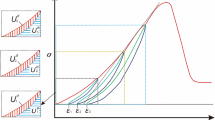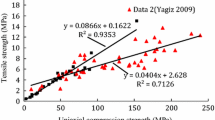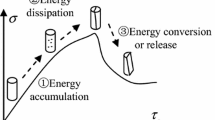Abstract
To evaluate rock brittleness more accurately, a new rock brittleness index based on the peak elastic strain energy consumption ratio (PEECR) was proposed in this study. Considering the relationship between rock brittleness and energy evolution characteristics of rock materials under confining pressure, the PEECR was defined as the dissipated proportion of peak elastic strain energy relative to failure energy and residual elastic strain energy (the maximum value of PEECR is 1.0, which indicates the corresponding rock will fail immediately after reaching the peak strength). The evaluation accuracy of the PEECR was verified based on the conventional triaxial compression tests on shale under six confining pressures, and the universality of the PEECR was also analyzed according to test data of six types of rocks from previous studies. The results show that the PEECR continuously decreases with the increasing of confining pressures, and is suitable for various types of rocks and a wider range of brittleness degrees. Finally, the evaluation accuracies of the PEECR and 11 existing rock brittleness energy indexes were compared and analyzed, and the results indicate that PEECR can evaluate rock brittleness more accurately.
Highlights
-
A new rock brittleness index based on peak elastic strain energy consumption ratio (PEECR) was proposed considering the relationship between the rock brittleness and energy evolution characteristics of rock materials under confining pressures.
-
It is verified based on conventional triaxial compression tests that PEECR can accurately evaluate rock brittleness, and is suitable for various types of rocks and a wider range of brittleness degrees.
-
The evaluation accuracy for rock brittleness of PEECR is higher than other existing indexes by comparison based on test results, and PEECR can be popularized in practical application.









Similar content being viewed by others
Change history
05 February 2022
A Correction to this paper has been published: https://doi.org/10.1007/s00603-022-02803-0
Abbreviations
- BIER :
-
Peak elastic strain energy consumption ratio
- E :
-
Pre-peak elastic modulus
- σ 1 :
-
Axial stress
- σ 3 :
-
Circumferential stress
- σ p :
-
Peak strength
- σ r :
-
Residual strength
- ε d :
-
Axial strain when peak stress is unloaded to 0
- ε r :
-
Axial strain at the beginning point of residual strength stage
- ε u :
-
Axial strain when the residual stress is unloaded to 0
- εp :
-
Peak axial strain
- U e p :
-
Peak elastic strain density
- U f :
-
Failure energy density
- U e r :
-
Residual elastic strain energy density
- U a :
-
Additional input energy density
- U ec :
-
Consumed elastic strain energy density during the failure process
- U d p :
-
Peak dissipated energy density
- U ei :
-
Peak elastic strain energy of the absolute brittle rock
References
Ai C, Zhang J, Li YW, Zeng J, Yang XL, Wang JG (2016) Estimation criteria for rock brittleness based on energy analysis during the rupturing process. Rock Mech Rock Eng 49:4681–4698
Cai M, Kaiser PK, Tasaka Y, Maejima T, Morioka H, Minami M (2004) Generalized crack initiation and crack damage stress thresholds of brittle rock masses near underground excavations. Int J Rock Mech Min Sci 41:833–847
Cai M, Hou PY, Zhang XW, Feng XT (2021) Post-peak Stress-Strain curves of brittle hard rocks under axial-strain-controlled loading. Int J Rock Mech Min Sci 147:104921
Chen Y, Jin Y, Chen M (2015) A rock brittleness evaluation method based on energy dissipation. Chin J Theor Appl Mech 47(6):984–993
Chen Y, Jin Y, Chen M, Yi ZC, Zheng XJ (2017) Quantitative evaluation of rock brittleness based on the energy dissipation principle, an application to type II mode crack. J Nat Gas Sci Eng 45:527–536
Copur H, Bilgin N, Tuncdemir H, Balci C (2003) A set of indices based on indentation tests for assessment of rock cutting performance and rock properties. J South Afr Inst Min Metall 103(9):589–599
Fan M, Jin Y, Chen M, Geng Z (2019) Mechanical characterization of shale through instrumented indentation test. J Pet Sci Eng 174:607–616
Gong X, Sun CC (2015) A new tablet brittleness index. Eur J Pharm Biopharm 93:260–266
Gong FQ, Yan JY, Li XB (2018) A new criterion of rock burst proneness based on the linear energy storage law and the residual elastic energy index. Chin J Rock Mech Eng 37(9):1993–2014
Gong FQ, Yan JY, Luo S, Li XB (2019) Investigation on the linear energy storage and dissipation laws of rock materials under uniaxial compression. Rock Mech Rock Eng 52:4237–4255
Gong FQ, Wang YL, Wang ZG, Pan JF, Luo S (2021) A new criterion of coal burst proneness based on the residual elastic strain energy index. Int J Min Sci Technol 31(4):553–563
Gong FQ, Shi RH, Xu L (2022) Linear energy storage and dissipation laws of concrete under uniaxial compression at different ages. Constr Build Mater 318:125963. https://doi.org/10.1016/j.conbuildmat.2021.125963
Guo TK, Zhang SC, Ge HK, Wang XQ, Lei X, Xiao B (2015) A new method for evaluation of fracture network formation capacity of rock. Fuel 140:778–787
Hajiabdolmajid V, Kaiser P (2003) Brittleness of rock and stability assessment in hard rock tunnelling. Tunn Undergr Space Technol 18:35–48
Hucka V, Das B (1974) Brittleness determination of rocks by different methods. Int J Rock Mech Min Sci Geomech Abstr 11(10):389–392
Huo ZP, Zhang JC, Li P, Tang X, Yang X, Qiu QL, Dong Z, Li Z (2018) An improved evaluation method for the brittleness index of shale and its application—A case study from the southern north China basin. J Nat Gas Sci Eng 59:47–55
Jaeger JC, Cook NG, Zimmerman R (2007) Fundamentals of rock mechanics, 4th edn. Blackwell Publishing, Malden
Jarvie DM, Hill RJ, Ruble TE, Pollastro RM (2007) Unconventional shale-gas systems: the Mississippian Barnett Shale of northcentral Texas as one model for thermogenic shale-gas assessment. AAPG Bull 91(4):475–499
Kaunda RB, Asbury BP (2016) Prediction of rock brittleness using nondestructive methods for hard rock tunneling. J Rock Mech Geotech Eng 8(4):533–540
Khandelwal M, Faradonbeh RS, Monjezi M, Armaghani DJ, Majid MZ (2017) Function development for appraising brittleness of intact rocks using genetic programming and non-linear multiple regression models. Eng Comput 33(1):13–21
Kim T, Hwang S, Jang S (2017) Petrophysical approach for S-wave velocity prediction based on brittleness index and total organic carbon of shale gas reservoir: a case study from Horn River Basin, Canada. J Appl Geophys 136:513–520
Kivi IR, Ameri M, Molladavoodi H (2018) Shale brittleness evaluation based on energy balance analysis of stress-strain curves. J Pet Sci Eng 167:1–19
Kuang ZH, Qiu SL, Li SJ, Du SH, Huang Y, Chen XQ (2021) A new rock brittleness index based on the characteristics of complete stress-strain behaviors. Rock Mech Rock Eng 54:1109–1128
Lai J, Wang GW, Huang LX, Li WL, Ran Y, Wang D, Zhou ZL, Chen J (2015) Brittleness index estimation in a tight shaly sandstone reservoir using well logs. J Nat Gas Sci Eng 27:1536–1545
Lawn BR, Marshall DB (1979) Hardness, toughness, and brittleness: an indentation analysis. J Am Ceram Soc 62(7–8):347–350
Li LL, Gong FQ (2020) Experimental investigation on the energy storage characteristics of red sandstone in triaxial compression tests with constant confining pressure. Shock Vib 10:1–11
Li N, Zou YS, Zhang SC, Ma XF, Zhu XW, Li SH, Cao T (2019a) Rock brittleness evaluation based on energy dissipation under triaxial compression. J Pet Sci Eng 183:1–10
Li LC, Zhai MY, Zhang LY, Zhang ZL, Huang B, Li AL, Zuo JQ, Zhang QS (2019b) Brittleness evaluation of glutenite based on energy balance and damage evolution. Energies 12(18):1–28
Li YW, Zhou LH, Li DP, Zhang SC, Tian FC, Xie ZM, Liu B (2020) Shale brittleness index based on the energy evolution theory and evaluation with logging data: a case study of the Guandong block. ACS Omega 5:13164–13175
Meng FZ, Zhou H, Zhang CQ, Xu RC, Lu JJ (2015) Evaluation methodology of brittleness of rock based on post-peak stress–strain curves. Rock Mech Rock Eng 48:1787–1805
Meng QB, Wang CK, Huang BX, Pu H, Zhang ZZ, Sun W, Wang J (2020) Rock energy evolution and distribution law under triaxial cyclic loading and unloading conditions. Chin J Rock Mech Eng 39(10):2047–2059
Meng FZ, Wong LNY, Zhou H (2021) Rock brittleness indices and their applications to different fields of rock engineering: a review. J Rock Mech Geotech Eng 13(1):221–247
Moghadam A, Harris NB, Ayranci K, Gomez JS, Angulo NA, Chalaturnyk R (2019) Brittleness in the Devonian Horn River shale, British Columbia, Canada. J Nat Gas Sci Eng 62:247–258
Shi X, Wang J, Ge XM, Han ZY, Qu GZ, Jiang S (2017) A new method for rock brittleness evaluation in tight oil formation from conventional logs and petrophysical data. J Pet Sci Eng 151:169–182
Shi GC, Chen G, Pan YT, Yang XL, Liu Y, Dai GZ (2019) Stress-drop effect on brittleness evaluation of rock materials. J Cent South Univ 26(7):1807–1819
Song HQ, Zuo JP, Chen Y, Li LY, Hong ZJ (2019) Revised energy drop coefficient based on energy characteristics in whole process of rock failure. Rock Soil Mech 40(1):91–98
Su YQ, Gong FQ, Luo S, Liu ZX (2021) Experimental study on energy storage and dissipation characteristics of granite under two-dimensional compression with constant confining pressure. J Cent South Univ 28:848–865
Suorineni FT, Chinnasane DR, Kaiser PK (2009) A procedure for determining rock-type specific Hoek-Brown brittle parameter s. Rock Mech Rock Eng 42(6):849–881
Tang XM, Xu S, Zhuang C, Su YD, Chen XL (2016) Quantitative evaluation of rock brittleness and fracability based on elastic-wave velocity variation around borehole. Pet Explor Dev 43(3):457–464
Tarasovn BG, Potvin Y (2013) Universal criteria for rock brittleness estimation under triaxial compression. Int J Rock Mech Min Sci 59:57–69
Tarasovn BG, Randolph MF (2011) Superbrittleness of rocks and earthquake activity. Int J Rock Mech Min Sci 48:888–898
Wang SF, Tang Y, Wang SY (2021) Influence of brittleness and confining stress on rockcuttability based on rock indentation tests. J Cent South Univ 28(9):2786–2800
Xia YJ, Li LC, Tang CA, Li XY, Ma S, Li M (2017) A new method to evaluate rock mass brittleness based on stress–strain curves of class I. Rock Mech Rock Eng 50:1123–1139
Xie HP, Ju Y, Li LY, Peng RD (2008) Energy mechanism of deformation and failure of rock mass. Chin J Rock Mech Eng 27(9):1729–1740
Yagiz S (2009) Assessment of brittleness using rock strength and density with punch penetration test. Tunn Undergr Space Technol 24(1):66–74
Yang SQ, Yin PF, Ranjith PG (2020) Experimental study on mechanical behavior and brittleness characteristics of Longmaxi Formation Shale in Changning, Sichuan Basin, China. Rock Mech Rock Eng 53:2461–2483
Zhang D, Ranjith PG, Perera MSA (2016) The brittleness indices used in rock mechanics and their application in shale hydraulic fracturing: a review. J Pet Sci Eng 143:158–170
Zhang Y, Feng XT, Yang CX, Han Q, Wang ZF, Kong R (2021) Evaluation method of rock brittleness under true triaxial stress states based on pre-peak deformation characteristic and post-peak energy evolution. Rock Mech Rock Eng 54:1277–1291
Zhou H, Chen J, Lu JJ, Jiang Y, Meng FZ (2018) A new rock brittleness evaluation index based on the internal friction angle and class I stress-strain curve. Rock Mech Rock Eng 51:2309–2316
Acknowledgements
This work was supported by the National Natural Science Foundation of China (Grant No. 42077244) and the Fundamental Research Funds for the Central Universities of Southeast University (Grant No. 2242021R10080, 3205002108C3).
Author information
Authors and Affiliations
Corresponding author
Additional information
Publisher's Note
Springer Nature remains neutral with regard to jurisdictional claims in published maps and institutional affiliations.
Rights and permissions
About this article
Cite this article
Gong, F., Wang, Y. A New Rock Brittleness Index Based on the Peak Elastic Strain Energy Consumption Ratio. Rock Mech Rock Eng 55, 1571–1582 (2022). https://doi.org/10.1007/s00603-021-02738-y
Received:
Accepted:
Published:
Issue Date:
DOI: https://doi.org/10.1007/s00603-021-02738-y




